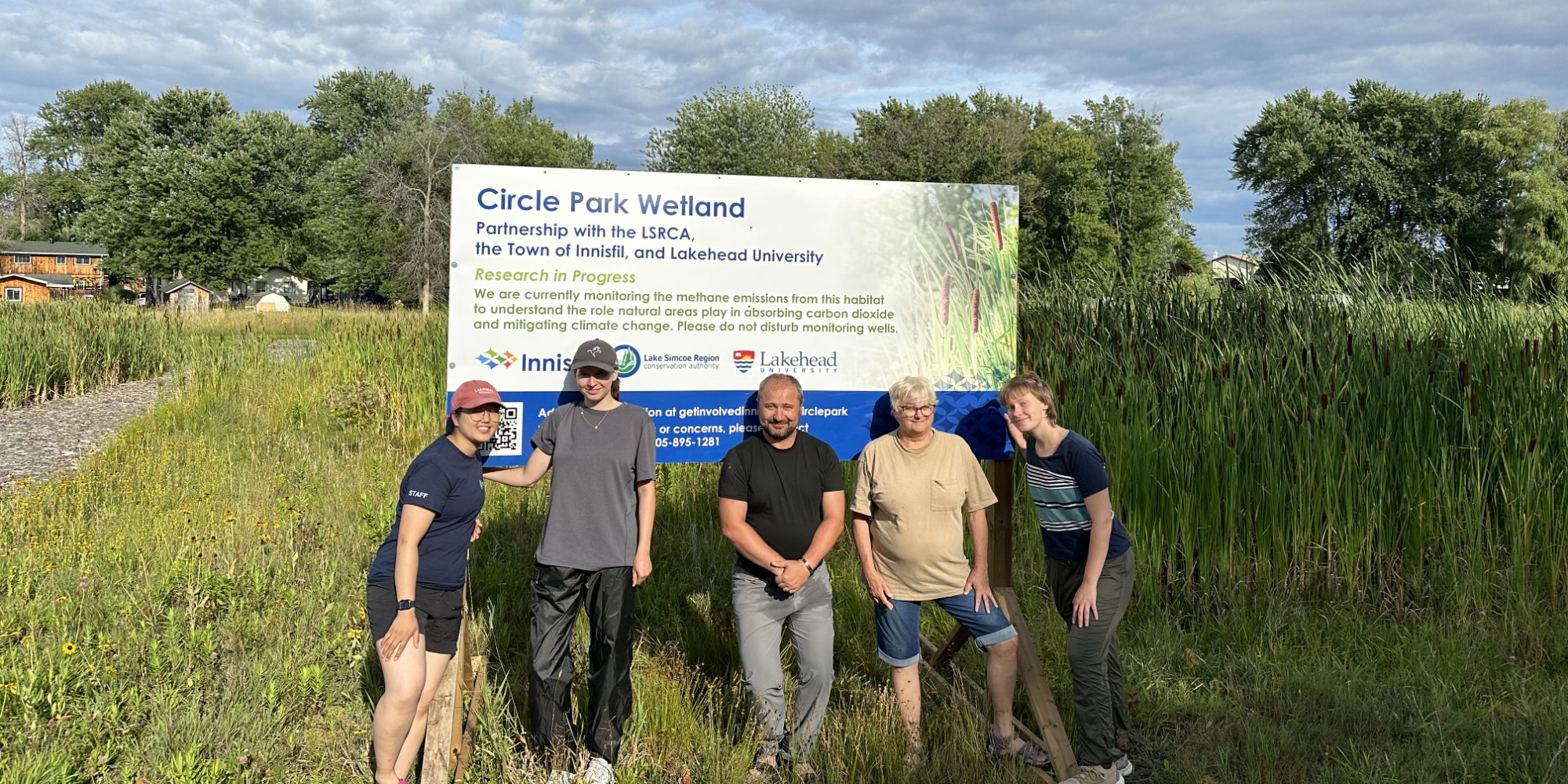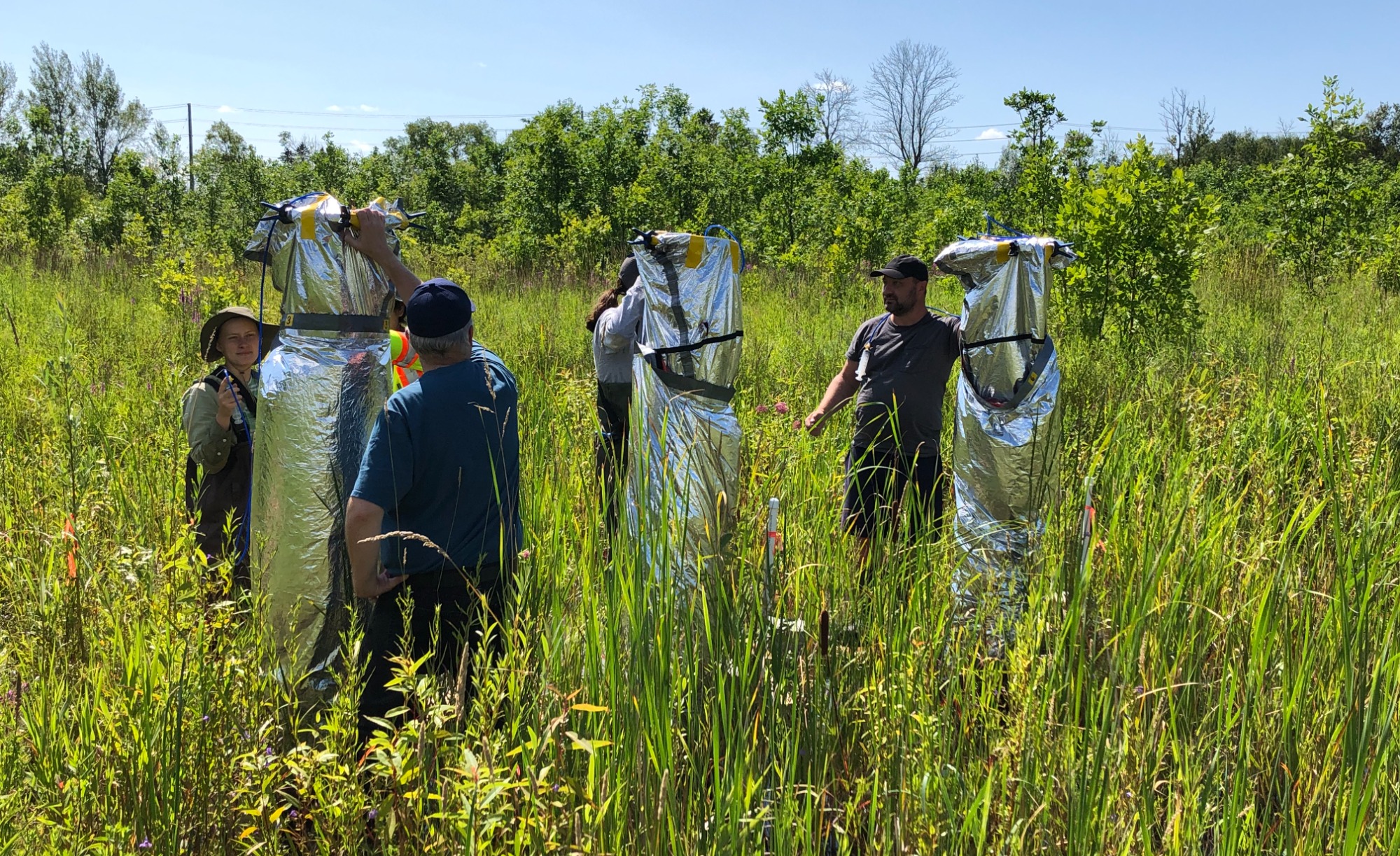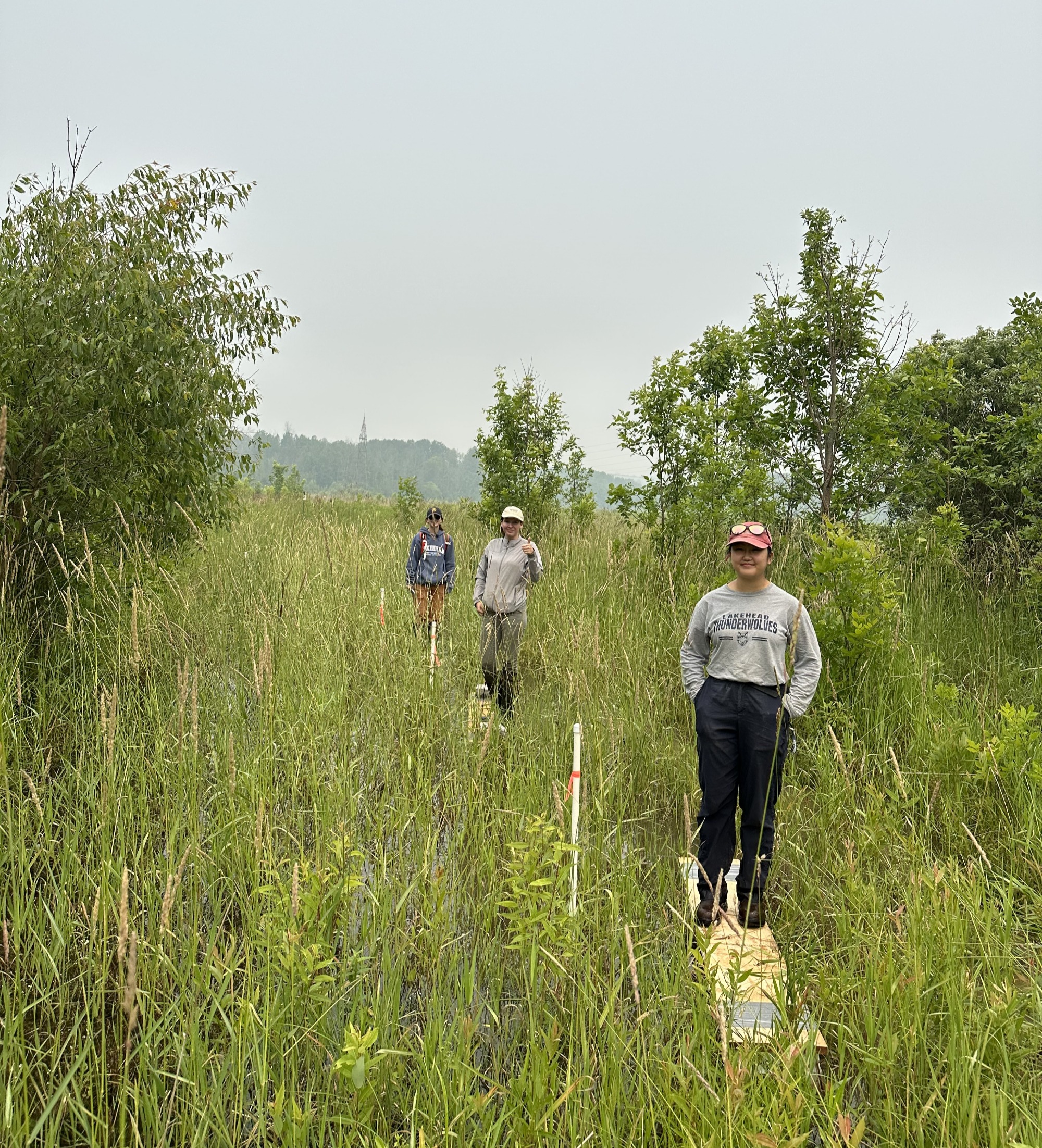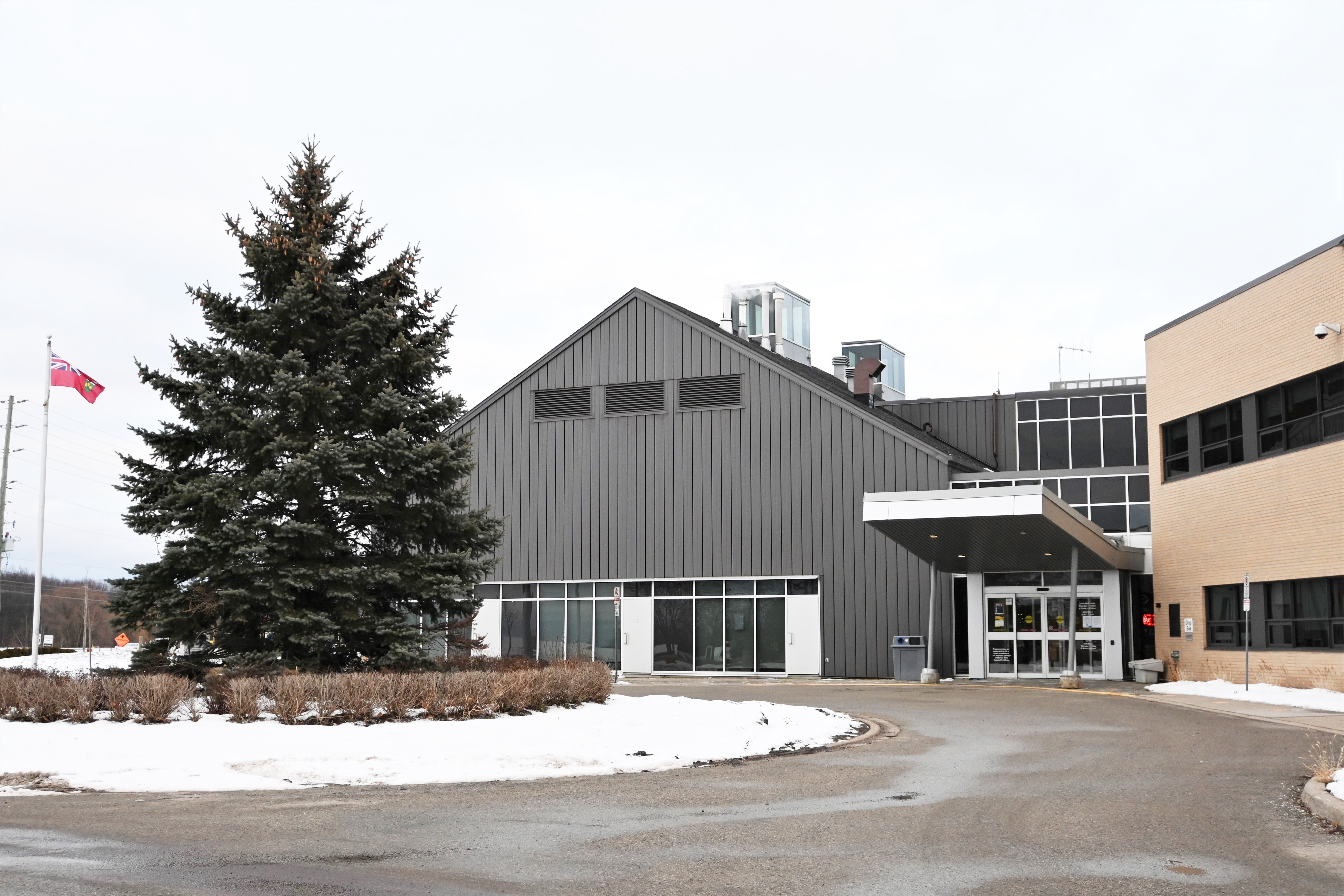Purpose-built wetlands hailed as 'Nature's Champions'

Town of Innisfil's Circle Park points the way in the fight against climate change
The following article was published by Lakehead University on May 2, 2024.
What began as a modest effort to turn an underused neighbourhood park into a pleasing natural habitat has blossomed into a rare opportunity to learn about climate change, which could serve as a model for municipalities across the country facing the biggest threat of our time—greenhouse gas-driven climate change.
A project between the Town of Innisfil and the Lake Simcoe Region Conservation Authority (LSRCA) to improve drainage at an urban park in Gilford, Ontario, has resulted in a purpose-built wetland and a partnership with Lakehead University to help understand the role that natural areas play in mitigating climate change.
“A constructed wetland like this has the potential to offer nature-based climate solutions for the mitigation of human-made greenhouse gas emissions,” says Dr. Florin Pendea, lead researcher and associate professor in the departments of geography and the environment as well as sustainability sciences at Lakehead University’s Orillia Campus.
“Although there are many constructed wetlands that have been purposely built in Canada for a variety of uses, such as storm water catchment and contaminated water treatment, the Circle Park wetland in Innisfil is, as far as we know, the first in Canada to be studied from day one in terms of its carbon capture capacity and greenhouse gas emissions.”
“It offers us an extraordinary model that can be replicated in municipalities across the country,” he says of these wetlands.
The 1.5 hectare (3.7-acre) Circle Park sits on a low-lying area near the shore of Lake Simcoe. Work began in 2021 and involved the creation of two basins, each about a metre deep, and the planting of vegetation, mostly cattails or bulrushes. The upland or drier sections include walking paths, lookout areas and wildflower meadows.

Before the wetlands were created, this small park was quite wet and relatively underutilized by local residents, explains Bill Thompson, manager, watershed plans and strategies for the LSRCA.
“The wetland creation work allowed us to both create the permanent pool wetlands and also to introduce some raised walking trails, so that people could access and enjoy them,” he says. “The conservation authority has a long history of projects like this, that try to bring a bit of nature and opportunities for nature appreciation to our watershed. As we’ve learned more about the impacts of climate change in the Lake Simcoe watershed, the opportunity to work with Lakehead University to study the role wetlands like these can play in offsetting greenhouse gas emissions was one that was too good to pass up.”
The partnership is also a strategic way to address the complex environmental challenges confronting local communities, emphasizing the role of local innovation and collaboration in tackling sustainability issues.
"Innisfil's commitment to environmental stewardship and innovation is clearly shown by the Circle Park initiative. This project not only enhances our community's natural habitat but also serves as a pioneering model for climate change mitigation," says Mayor Lynn Dollin. "Our collaboration with the Lake Simcoe Region Conservation Authority and Lakehead University underscores our dedication to finding nature-based solutions to environmental challenges, ensuring a sustainable future for all."
Pendea, who has partnered with the conservation authority since 2017 and with Dr. Gail Chmura from McGill University since 2023, saw this purposely-built wetland as a chance to monitor carbon sequestration, or the ability to remove heating-causing greenhouse gases from the atmosphere. These water-logged conditions slow the decomposition of biomass, keeping it from going into the air as carbon dioxide (CO2).
“In principle that's why wetlands in general are very important,” Pendea says, noting that wetlands cover about four-per-cent of the world's surface but store one-third of terrestrial soil carbon.
“Wetlands really have a lopsided role in the general climate system because of this capacity to absorb and store carbon, not just short-term but on a centennial or millennial scale as well,” he adds.
Wetlands, often called the “Kidneys of Nature,” act to clean waterways. But there is a dark side. Because they are an oxygen-poor environment they also produce other greenhouse gases, notably methane. This is where Pendea, Chmura, the LSRCA and their team of students come in: they're monitoring the absorption of carbon from the atmosphere as well as the emission of gases into the atmosphere due to this unique play of forces, to try to determine the “true carbon balance” of these systems.
“We know we're going to emit greenhouse gases,” Pendea concedes. “But can we find ways to mitigate some of that? Ideally mitigate the same amount as we produce.”
In the case of Circle Park, the answer is the two-metre-tall cattails, which are productive in absorbing CO2. Measurements of greenhouse gases were conducted last summer, then again in the fall and, this year, in February. Pendea's team will be out again this week (April 22-26).
“When we do the math it sounds like these wetlands actually are or can be viewed as nature-based climate solutions,” Pendea states. “On balance more carbon is stored than is emitted back into the atmosphere.”

Final calculations are still to be made and Pendea cautions that his outlook is based on preliminary findings. There was concern that nutrients from agricultural fertilizers, a powerful source of nitrous oxide, a so-called “greenhouse gas on steroids,” might tip the balance into the negative. So far it appears these built ecosystems can absorb it, which might offer a way forward in the fight against global warming, which Pendea regards as the number one existential problem in the world today.
More data will be available after the latest round of testing. He expects monitoring to continue for another two years.
“We want to have the full picture of these wetlands as living systems,” he says. “Most importantly we want to be able to inform Canadian policymakers: Is this a good idea? Is this a great idea? Is this a bad idea?”
“That's why this partnership with the Town of Innisfil and the LSRCA is so important. After these years of work we will be able to say, 'Construct wetlands because that is a way for you to mitigate emissions in your jurisdiction'.”
For historical and background information related to the development of Circle Park, visit GetInvolvedInnisfil.ca/CirclePark.

